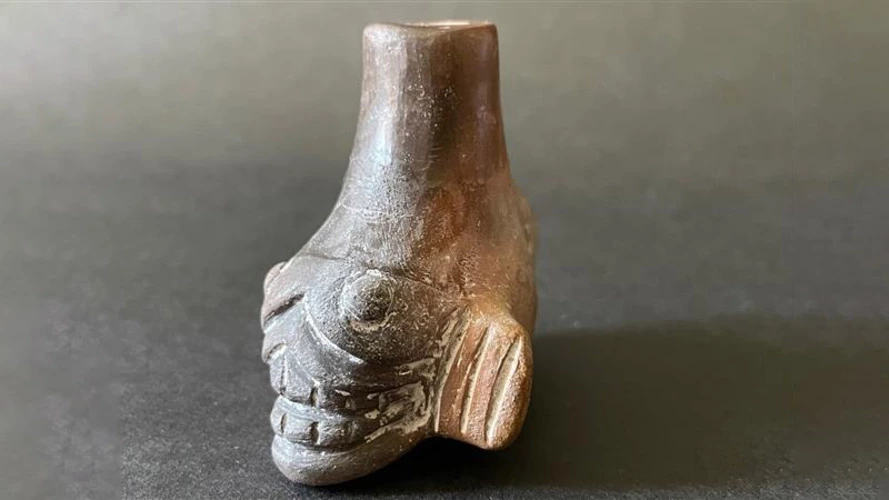The spine-chilling scream-like sounds of Aztec skull whistles—ancient artifacts often referred to as “death whistles”—have long fascinated archaeologists and historians.
Now, in groundbreaking research recently published in Communications Psychology, scientists from the University of Zurich have unveiled the intricate psychoacoustic role of these eerie ancient Aztec devices. Their findings reveal that the whistle’s piercing screams can trigger deeply unsettling effects on the human brain, shedding light on its potential impact on Aztec society.
The findings also provide a window into ancient Aztec culture and highlight the powerful influence of sound on shaping human perception and emotion.
“The whistles have a very unique construction, and we don’t know of any comparable musical instrument from other pre-Columbian cultures or from other historical and contemporary contexts,” lead study author and Professor of Cognitive and Affective Neuroscience at the University of Zurich, Dr. Sascha Frühholz, said in a statement. “[The] Skull whistles thus seem unique sound tools with specific psycho-affective effects on listeners, and Aztec communities might have capitalized on the scary and scream-like nature of skull whistles.”
Listen to the terrifying sounds of the Aztec death whistle below. (Source: University of Zurich, Dr. Sascha Frühholz, et al)
For decades, Aztec death whistles have captured the imagination of archaeologists, historians, and casual enthusiasts.
Discovered in the 19th century, the Aztec death whistle is believed to originate from the postclassic Mesoamerican period, spanning 1250–1521. These small clay instruments, shaped like skulls and measuring 3–5 cm, boast a remarkably intricate internal structure. Featuring a tubular air duct, collision chambers, and a bell cavity, the design ingeniously channels airflow to produce a sharp, bone-chilling sound eerily similar to a human scream.
The skull-shaped design of the death whistle has prompted researchers to associate it with Mictlantecuhtli, the Aztec lord of the underworld. Others suggest that its howling, wind-like tones might symbolize Ehecatl, the Aztec god of wind, who, according to Mesoamerican mythology, ventured into the underworld to retrieve the bones of a previous age and create humankind.
Adding to its mystique, death whistles have been predominantly discovered in ritual burial sites tied to human sacrifices, leading to speculation that they served as ceremonial symbols of the mythological journey into Mictlan, the Aztec underworld.
While the instrument has captured popular imagination—most notably appearing in the 2021 film Ghostbusters: Afterlife—scientific exploration of the death whistle has been limited. Its exact purpose and significance in Aztec society remain an intriguing mystery.
To better understand the physical mechanisms behind this terrifying device and its impact on listeners, researchers at the University of Zurich led by Dr. Frühholz conducted one of the most comprehensive studies of the Aztec death whistle to date.
Dr. Frühholz and his team utilized computer tomography (CT) scans and 3D modeling to reconstruct original Aztec death whistles from the Ethnological Museum in Berlin. By playing these reconstructions with varying air pressures, the researchers generated over 270 audio recordings, revealing key acoustic features of the instrument through detailed analysis.
The death whistle’s sound was characterized by its “rough and piercing” qualities, closely resembling human screams or mechanical alarms. These characteristics make them highly effective at grabbing attention and evoking fear. Spectral analysis revealed three primary psychoacoustic effects:
- Broadband Noise: Producing rough, turbulent sounds that resemble biological distress calls.
- Pitch Characteristics: High-pitched elements that mimic the shrill quality of a scream.
- Nonlinear Dynamics: Sudden, irregular sound bursts that heighten their startling effect.
Another sample of the sounds of the Aztec death whistle below. (Source: University of Zurich, Dr. Sascha Frühholz, et al)
After unraveling the death whistle’s acoustic properties, researchers turned their attention to its psychological effects on listeners.
To explore this, they conducted seven listening experiments with 70 volunteer participants. These tests evaluated the emotional response, perceived urgency, and the naturalness of the death whistle’s sounds, compared to other auditory stimuli such as human screams, animal calls, and natural sounds like wind and rain.
Participants consistently described the sounds of the death whistle as “aversive,” “scary,“ and “unnatural,“ with “scream“ being the most commonly assigned label. The sounds evoked intensely negative emotions, including fear and discomfort, and listeners noted a strong sense of urgency, akin to the reaction triggered by an alarm.
Interestingly, the whistle’s sound was perceived as having a hybrid quality, blending elements of human voices with artificial, mechanical characteristics. Researchers noted that this suggests “a hybrid natural-artificial status of skull whistle sounds, such that they are primarily associated with a human origin but also form associations with sounds produced by technical objects and processes.”
“This is consistent with the tradition of many ancient cultures to capture natural sounds in musical instruments and could explain the ritual dimension of the death whistle sound for mimicking mythological entities,“ Dr. Frühholz explained.
Taking their investigation further, researchers conducted a neuroimaging study using functional magnetic resonance imaging (fMRI) to examine the brain’s response to the haunting sounds of the death whistle.
Results revealed that the sounds of the death whistle activated a network of brain regions associated with auditory processing and emotional evaluation.
Neuroimaging showed heightened activity in the auditory cortex, where basic sound features are decoded, as well as in higher-order brain areas like the lateral (IFC inferior frontal cortex), medial frontal cortex (MFC), and the insula.
These areas are involved in interpreting emotional significance and symbolic meaning. The study highlighted that the whistle’s scream-like sounds triggered neural responses similar to those elicited by aversive stimuli, such as human screams, emphasizing its capacity to evoke fear and urgency.
This suggests that the whistle’s unique sound draws immediate attention and engages deeper cognitive and emotional processing, underscoring its psychological potency.
Although this recent study did not aim to pinpoint the exact role of the death whistle in Mesoamerican culture, researchers observed that “Aztec communities might have capitalized on the aversive and frightening nature of skull whistle sounds in specific contexts.”
One popular theory is that the death whistles were employed as tools of psychological warfare during battles. Their piercing, scream-like sounds would have sown fear and confusion among enemy forces, disrupting their composure and potentially providing the Aztecs with a tactical advantage. When played in unison, many whistles could create a deafening cacophony, resembling a chorus of human screams and amplifying the psychological impact on opposing armies.
However, researchers noted that the strong association between the death whistle’s sounds and higher-order cognitive processing suggests that its use in warfare is “rather unlikely.“
Instead, the evidence points to a ceremonial role, as the whistles have predominantly been discovered in ritual burial sites associated with human sacrifices.
“Skull whistles might have been used to scare the human sacrifice or the ceremonial audience, but further cross-documentation is needed here,“ researchers wrote. “The symbolic and associative meaning might be specifically related to the dangerous and scary travel of the dead to the underworld.“
Beyond their historical significance, this recent research on the Aztec death whistle provides insights into how sound influences human cognition and emotion. The findings demonstrate that understanding the psychoacoustic effects of ancient instruments like the death whistle can potentially inspire researchers to develop more effective ways to capture attention or evoke specific emotions.
The study also bridges gaps between archaeology, neuroscience, and acoustics, opening avenues for interdisciplinary research into how ancient cultures harnessed sensory experiences.
Researchers have illuminated a captivating intersection of sound, culture, and human psychology in unraveling the mysteries of the Aztec death whistle.
This ancient artifact, with its terrifyingly precise design, not only offers a glimpse into the rituals and beliefs of the Aztec civilization but also underscores the enduring power of sound to shape human emotion and perception.
Ultimately, the exact purpose of the death whistle in Aztec culture remains mysterious. Yet, recent findings strongly indicate that this instrument was deliberately designed to evoke fear and unease.
Its haunting sounds invite modern audiences to ponder the ingenious ways the ancient Aztecs harnessed sensory experiences to communicate, intimidate, and leave a lasting impression on those who encountered their traditions.
Tim McMillan is a retired law enforcement executive, investigative reporter and co-founder of The Debrief. His writing typically focuses on defense, national security, the Intelligence Community and topics related to psychology. You can follow Tim on Twitter: @LtTimMcMillan. Tim can be reached by email: tim@thedebrief.org or through encrypted email: LtTimMcMillan@protonmail.com

